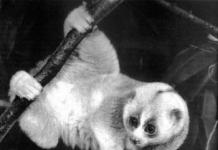Loris are animals belonging to the order of primates, suborder of prosimians. They are often called lemurs, which is generally incorrect. Lemurs ( Lemuridae) is a family of prosimians found exclusively in Madagascar. Representatives of several more families - dwarf lemurs ( Cheirogalidae ), thin-bodied lemurs ( Megaladapidae ), indri ( Indridae ), arms ( Daubentoniidae ) - are also endemic to this island.) Different species of the loris family ( Loridae They are very widespread - in a large part of Africa (but not in Madagascar), in South and Southeast Asia. From other families of prosimians, and this group also includes African galagos ( Galagonidae) and tarsiers (
Tarsiidae ) from Southeast Asia, the loris is distinguished by the absence of a tail. More precisely, they have a tail, but it is so small, 1.5–2 cm, that you won’t even notice it.(This article will focus on the Asian lorises that inhabit India, part of China, the countries of Southeast Asia and the surrounding islands, including Borneo, Sumatra and Java. There are three species of Asian lorises:), thin(Loris tardigradus small Nycticebus pygmaeus() And) thick Nycticebus coucang
Lorises lead an arboreal lifestyle and in natural conditions practically do not descend to the ground. Both the front and hind limbs of these animals are maximally adapted for climbing and have well-developed fingers and nails. Only on the ring toe do they have a rather long claw, which is called “cosmetic”, since with its help the animals take care of their fur. In captivity, lorises feel comfortable only by holding on to something with at least one limb. For their size, these animals are very strong: if a loris gets caught on something with its fingers closed, it is very difficult to unhook it.
Lorises are nocturnal animals; they spend the day curled up in a tight ball in a fork of branches and firmly grasping the branches with their paws, or nest in hollows of trees or other shelters located at heights. When darkness falls, they go out hunting, moving along tree branches and vines. The main part of their food in nature consists of various insects, terrestrial mollusks, small vertebrates, and bird eggs.
On occasion, they will not refuse juicy and sweet fruits and vegetables. In captivity, it is very difficult to create a diet for loris that is close to natural.

In general, despite the relative abundance of these animals (this does not apply to the slender loris, which is considered an endangered species), their life in nature has been poorly studied. Lorises are very secretive and try to stay high in the thicket of branches, which makes observing them much more difficult. At night, when the animals are most active, you can recognize their presence only by the shine of their eyes, glowing with reflected light in the beam of a flashlight. So most observations of their behavior were made in captivity - lorises are kept in some zoos (where conditions have been created for demonstrating nocturnal animals) and in various research centers.
It should be noted that several years ago a real boom in keeping loris in apartments began in Moscow. In the markets of Southeast Asia, these animals are sold at fairly low prices, which provokes traders to buy them in large quantities and transport several individuals simply in bags in the cargo compartments of airplanes. If animals do not die from thirst, exhaustion, hypothermia, or wounds inflicted on each other in such an environment, then in the future many of them may develop diabetes as a result of the stress they endured, and without special treatment they will quickly die. Naturally, not every animal lover is able to create at home the conditions necessary to keep these animals. As a result, lines of sad loris owners with weakened or already dying animals in their arms reached veterinary clinics and zoos. Very often they bring in animals that cannot be saved.
In addition, many, having bought a loris as a pet, find themselves disappointed, since it is difficult to establish contact with this animal and pet it, to put it mildly. Lori usually sleeps all day long somewhere in the corner, curled up in a ball, and in order to be picked up, he must first be literally torn away from what he is sitting on and what he has a death grip on. At the same time, loris bites are very painful; there are even known cases when they caused anaphylactic shock.

The Moscow Zoo now houses small and slow lorises - most of them were once acquired as pets, and then became ill or simply became undesirable in apartments.
Although in nature lorises are usually solitary, in captivity they willingly live in pairs (male and female), groups (male and several females), or family groups (pair of parents and cubs). Naturally, a group of loris, even a family one, requires a fairly large enclosure - at least 15–20 m2, otherwise conflicts that end in deep lacerations and stress cannot be avoided.
To mark his territory, the male marks its boundaries with urine and constantly monitors the renewal of scent marks (which, by the way, is another unpleasant aspect of keeping these animals at home).
Washing off these marks when keeping lorises in enclosures creates a very stressful situation for them and can ultimately even lead to the death of the animal.
In general, observing the behavior of lorises even in the familiar environment of a familiar enclosure is very difficult. They are capable of freezing for a long time in some bizarre position or quickly running for cover if they realize that they are being watched.

True, even without being frightened, lorises can move along branches quite quickly - for example, when a male runs around his territory and marks it. A smoother and even somewhat slower nature of movements distinguishes the slow lorises - for this they are also called slow lorises.
In recent years, lorises, like many other representatives of the animal world, have been experiencing severe pressure from humans - this is the active hunting of animals, and deforestation, and simply the intensification of human activity in the farthest corners of tropical forests. And since the distribution areas of these animals have not yet been fully clarified, and in some species they are intermittent and can be very small, as a result of the next clearing in the forest, you can lose some species or subspecies without even fully studying it. This is approximately the current situation with the slender loris.
The popular name of the animal lemur lory became famous in connection with the expensive acquisitions of exotic animals as domestic pets.
This mammal is considered one of the few surviving oldest animals on the planet. All representatives of the species are classified as protected objects and included in.
Features and habitat
The animal is easy to remember once you see its large eyes, surrounded by dark spots and separated by a yellowish stripe. Nature has endowed him with good night vision thanks to the reflective substance tapetum, which allows him to navigate in the dark. The eyes may have given rise to the name "Loeris", which means "clown" in Dutch.

In 1766, the French naturalist Georges Buffon called the loris a prosimian (lemur), when it was thought to be slow. Today there are three main types:
- slender loris;
- slow loris (lemur loris);
- dwarf (small) loris.
Each species is divided into several subspecies. Zoologists consider them to be a species of wet-nosed primates, mistakenly classified as.
The forests of South and Southeast Asia in Vietnam, Cambodia, Laos, and India are home to the distribution of funny animals. The homeland is considered to be Malaysia, Indonesia, Thailand, and Singapore.
The body of the animal, depending on the species, ranges in size from 20 to 40 cm, and weight from 0.3 to 1.6 kg. Loris are covered with short, dense and soft fur of a brownish or yellow-gray color.

Pictured is a slender loris
The abdomen is always lighter in color. A dark stripe always runs along the spine like a belt. Small head with a short muzzle. The ears are small and round. The tail is either completely absent or protrudes 1.7-2 cm and is covered with hair, so it is hardly noticeable. Lori is fat distinguished by the presence of white areas on the head.
The fore and hind limbs are approximately equal in size, equipped with grasping and tenacious hands and feet. The toes have nails, which include special “cosmetic” claws for grooming.
Unusual big-eyed animals live on the tops of trees, in dense crowns. Different species live in lowland forests or high mountains. They almost never descend to the ground and lead an arboreal lifestyle.

Pictured is a slow loris
Lories are often called slow for their indifference to sudden and fast movements. Sad eyes emphasize their individual expressiveness.
Character and lifestyle
Lemur loris - animal night. Activity begins in the evening, night is the time of hunting, and the animal falls asleep only after the sun rises. Bright light is contraindicated for them; they can go blind and die from the blinding rays. Twilight is a comfortable living environment.
They sleep in balls of fur in the trees, holding their feet to a branch and hiding their heads at their feet. The animal can find a convenient place to rest in a hollow or fork in the branches.

Loris move slowly, carefully, grasping the branches from below with all their paws. At the slightest danger, they freeze and can remain motionless for a long time, without moving a single leaf, until the threat from some predatory night bird passes. Animals have excellent hearing.
They are naturally curious and playful. They explore and know their territories well. The animals are very tenacious and strong for their small size; their limbs are ideally suited for climbing branches.
It is known that lorises, in addition to hunting insects and small vertebrates, remove the bark of individual trees and drink the secreted sap. In nature, they never suffer from periodontal disease. There are lorises that are individualistic, having their own areas and leading a solitary lifestyle. And some species do not tolerate loneliness and live in pairs.

In captivity, as a rule, they live in family pairs or groups (a male and several females or a parent pair and cubs). Lorises protect their territory from random incursions of their relatives.
They always stay hidden, in the thick of green branches at a height, which makes it difficult to conduct research behind them. Many conclusions were drawn from studying animals in captivity at research centers.
The voices of lorises are different: at a great distance you can hear a whistle, and up close you can hear chattering sounds with cubs. Animals have the ability to communicate in an ultrasonic range that is inaudible to humans. You can observe animals silently pushing each other with their paws.
The exchange of information may occur in parallel at another level. Sometimes a ball of fur is formed from several lorises intertwined with limbs and hanging on a tree.

This is how they communicate, play, conduct their tidbit section and determine the internal hierarchy. The seemingly harmless animal has a secret and terrible weapon. The animal's elbows contain glands containing poison, the contents of which are sucked out and mixed with saliva. The bite can be fatal. But, fortunately, such danger overtakes the loris infrequently; secret weapons are used in exceptional cases.
Eating the lemur loris
In nature, the loris' diet consists of various crickets, lizards, and their eggs. A special feature of the loris is the ability to feed on poisonous caterpillars and insects, as well as consume tree resin. Plant food also plays an important role: the loris never refuses fruits, vegetables, herbs, and flowering parts of plants.

In captivity, animals are fed baby cereals with added oils, honey, fresh juices, vitamin complexes, and dried fruits. It should be noted that individual individuals have their own taste preferences and habits. In general, the diet should be rich in calcium and protein.
House lemur lory can be tamed if it receives its favorite food from the hands of its owner. Insects for feeding should be purchased from pet stores to avoid infections from random street carriers.
Reproduction and lifespan
Animals are selective in their search for a mate; individuals of different sexes cannot always form a family. Pregnancy lasts a little more than 6 months and, as a rule, 1-2 cubs are born. The babies appear covered in fur, with their eyes open. They hold tightly to the mother's belly, clinging to the fur.
The female carries the baby on herself for about 1.5-2 months. Lactation lasts approximately 4-5 months. Babies can wander from mother to father or close relative, hang on them, and then move to their mother for feeding.

Parents take care of their offspring jointly, but maternal activity is still higher. Only after a year and a half, the stronger offspring become independent and begin to start their own families.
Life expectancy is on average 12-14 years. There are examples where good care significantly increased life expectancy lemur loris.How long do they live? in captivity, depends on the absence of infections and the creation of conditions close to natural. Animals can survive up to 20-25 years.
Unfortunately, a fashion has arisen for breeding loris. Price funny animal is tall, but exotic lovers are trying to make a business out of keeping young animals for sale lemur loris. Buy an animal is possible, but without special knowledge and skills in handling the most ancient genus, it is difficult to win the trust of the big-eyed primate.
Slender lorises are lemurs belonging to the Loriidae family. They live in South India and Sri Lanka.
Lorises stick to forested areas and can climb mountains to a height of about 1800 meters. Locals call the slender loris tewangu.
Features of the appearance of slender lorises
Slender lorises are medium or small in size - they reach 17-25 centimeters in length. They weigh on average 340 grams. The tail is not visible from the outside.
The hind and forelimbs are approximately the same length. On the front and hind legs, the first toes are noticeably opposed to the rest. The head is round in shape, the front part is slightly elongated. The ears are round, thin, quite large, and have no hair at the edges. The eyes are big.

The fur of the slender loris is soft and thick. The color of the coat can be yellow-gray and dark brown on the back, and gray-silver or dirty yellow on the belly.
Lifestyle of the slender loris
Slender lorises are active at night, and during the day they sleep in trees, curling up into a ball and holding onto a branch with their paws. Slender lorises are practically arboreal animals. They move slowly; while moving, they intercept branches with their paws one at a time.
When the sun sets, the lorises wake up, leisurely stretch and preen their fur.
 Slender lorises are rather leisurely and very cute animals.
Slender lorises are rather leisurely and very cute animals. They perform hygiene procedures using a toilet claw and a tooth comb. Having tidied up the fur, the loris goes in search of food. In the darkness, the large eyes of thin lorises shine like coals.
Slender lorises move along small branches. They are held on branches with the help of their long fourth finger, which also helps them quickly grab food.
Slender lorises live in individual areas, which they mark with urine. They live in small groups. The diet mainly consists of lizards, tree frogs, birds and their eggs. The animals grab the prey with their front paws and then hit them against branches to kill them.

Lorises are capable of making about 6 different sounds, including chirping and low grunts. A special habit of slender lorises is to spray branches with urine while moving, and they also wet their paws. This is how lorises mark their territory.
Reproduction of slender lorises
The breeding season for slender lorises occurs from April to May and from November to December. The gestation period is approximately 6 months. Most likely, females have up to two offspring per year.
Slender lorises give birth to one or two babies. Children do not leave their mother for a year.

Slender lorises get along well in captivity. Lorises often sleep suspended in cages, clinging to the crossbar. They are fed not only insects, but also fruits, rolls and milk.
Domain - Eukaryotes
Kingdom - Animals (Metazoa)
Type - Chordata
Class - Mammals (Mammalia)
Squad - Primates
Family - Loridae
Genus - Lori (Nycticebus)
View - Laurie thin
The slender loris prefers to live solitary or in small groups. The occupied territory is marked with urine.
In the southwest of India, where the Western Ghats stretch along the Indian Ocean coast, tracts of tropical rainforests have been preserved. They extend further south to the fabulously beautiful island of Sri Lanka (Ceylon). One of the most amazing inhabitants of these forests is the nocturnal primate - the slender loris. Indians call them Tewangu.
This is a small animal whose length does not exceed 25 cm, and its weight does not exceed 400 g. The head of the slender loris is large and round, the muzzle is sharp but short, and the ears are large. The eyes are round and very large, separated by a narrow white stripe, and dark circles around the eyes. The thumb is opposed to the other fingers. On the second toe of the hind paws, Loriids have claws for cleaning fur, typical of wet-nosed primates. The tail is missing. The limbs are thin, the fur is long and velvety; above it is reddish-gray and yellowish-brown in color, below it is grayish or pale yellow; the fur around the eyes is darker. The protruding ears of the slender loris distinguish it from the slow loris, which has a head similar to the slender loris, but its small ears are almost buried in the fur. Another difference: thin and longer limbs, as well as a slightly sharper muzzle downwards.
During the day he sleeps soundly, curled up somewhere in the fork of a tree. At dusk, the slender loris comes out to hunt. Its slowness is deceptive - it deftly catches not only insects, but also tree frogs and lizards. Birds often fall into his tenacious hands. Loris often destroy bird nests, eating eggs and chicks.
Except for the breeding season, males and females live apart. They breed in April - May and November - December. Pregnancy lasts 160-170 days (according to some authors, only 108). The female brings one, rarely two, babies. After giving birth, parents quickly separate. When the cubs are born, they hold tightly to the fur on their mother’s belly, never leaving her side for more than a year. In captivity, these animals practically do not reproduce. And in general, slender lorises are rarely kept in captivity due to their sensitive and hot-tempered nature. They are frightened by any novelty, light and unfamiliar noise. And besides, they are listed in the Red Book as they are endangered.
- (Loris), a genus of prosimians of the loris family (see LORI (prosimians)). 1 species of slender Ceylon loris (L. tardigradus). Small graceful animals weighing 85,350 g, head and body length about 26 cm, no tail. The limbs are thin, slender,... ... encyclopedic Dictionary
slender loris- lieknieji loriai statusas T sritis zoologija | vardynas taksono rangas gentis apibrėžtis Gentyje 1 rūšis. Paplitimo arealas – P. Indija, Ceilonas. atitikmenys: lot. Loris English Ceylon sloths; lorises; slender lorises vok. Loris rus. slender loris... ... Žinduolių pavadinimų žodynas
LORI (Loriaceae, Lorisidae; Lorisidae), family of prosimians (see PROMIPES). Body length is from 22-26 cm to 35-40 cm. The tail can be short or long, there are tailless species. The median incisors of the upper jaw are separated from each other by a gap.... ... encyclopedic Dictionary
Loris, two genera of prosimians in the Loriidae family. Thin L. (Loris tardigradus) is the only species of the genus Loris. Body length is 20–25 cm, weighs 85–350 g. The fur is thick, fluffy, gray or reddish brown. The limbs are thin, almost the same length.... ...
I Loris are two genera of prosimians of the Loriidae family (See Loriaceae). Thin L. (Loris tardigradus) is the only species of the genus Loris. Body length 20-25 cm, weighs 85-350 g. The fur is thick, fluffy, gray or reddish brown. The limbs are thin, almost... Great Soviet Encyclopedia
Lorizids are divided into two subfamilies: 1. loris lemurs (Lorisinae) with the genera of thin loris (Loris), thick loris (Nycticebus), perodicticus, or common potto (Perodicticus), and Calabar potto, or arctocebus... ... Biological encyclopedia
- (Lorisidae)** * * These primates are characterized by a short tail and very large eyes. They have a tenacious grip of the fingers, due to the special structure of the tendons, movable joints and a dense network of blood vessels supplying the muscles... ... Animal life
- (Lorisidae), family of prosimians. Fossils (eg Indra loris) are known from the Pliocene of India. Dl. bodies from 22 26 to 35 40 cm. The tail is short (hidden in thick hair) or long, it may be absent. Hands and feet are grasping. Eyes… … Biological encyclopedic dictionary
This term has other meanings, see Loriaceae (meanings). ? Loriaceae ... Wikipedia
- (common potto) (Perodicticus potto) is the only species of the same genus of prosimians of the Loriidae family (see LORI (prosimians)). Common pottos are similar to slow loris (see THICK LORIES), but have a tail (6-8 cm). Their mass is 1000-1400 g, and ... encyclopedic Dictionary
Books
- The Gun Trader, Hugh Laurie. The famous British actor Hugh Laurie, inspired by the literary successes of his friend and colleague Stephen Fry, wrote a parody action film. Elegant style, subtle jokes, charming characters and...


















